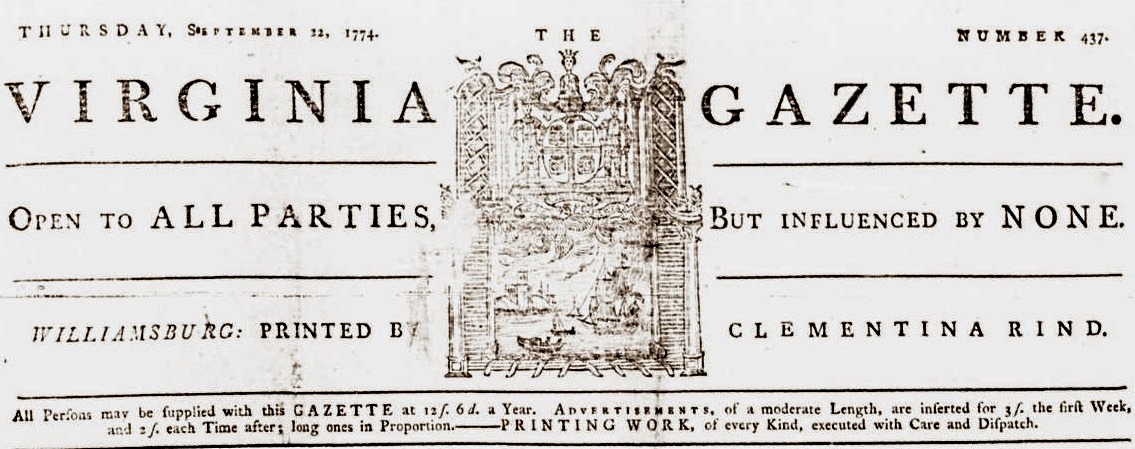Though little is known of Clementina’s early life, she and her husband arrived in Williamsburg from Maryland in late 1765 or early 1766 on the invitation of influential Virginians, including Thomas Jefferson, to start a newspaper to compete with the already established Virginia Gazette.
The first issue of Rind’s Virginia Gazette was published May 16, 1766 with the motto, “Open to ALL PARTIES, but Influenced by NONE.” For seven years Rind built a successful newspaper and printing business in Williamsburg, also winning the appointment of public printer to the colony. But in 1773, in the midst of his success, William died from what was described as a “tedious and painful illness” at age 39.
“As Clementina traversed the liminal space that Saturday morning after the funeral,” explains biographer Martha J. King, “she was not simply retreating to a private domestic life but also entering a public arena as a printer’s widow. Home and work were integrally tied. With living quarters and printing office under the same roof, it is likely that Clementina and her older children had worked alongside William Rind (Virginia Women: Their Lives and Times, 75).”
Faced with the death of her husband and the reality of supporting her family without him—a daunting prospect, for sure—she seized the opportunity and used her skills to carry on as printer of the Virginia Gazette. She continued William’s endeavor without any suspension in publication and in the same issue of the Gazette which printed William’s obituary, Clementina is named as its printer.
In the next week’s issue, published September 2, 1773, she wrote a candid introduction, “Being now unhappily forced to enter upon business on my own account, I flatter myself those gentlemen who shall continue to oblige me with their custom will not be offended at my requesting them, in future, to be punctual in sending cash with advertisements, &c.” She went on to say, “I will try to support, with fortitude, the painful sensation of incertainty, by a firm reliance on that candour and generosity, which have ever been the characteristic of that honourable body.”
For the next year, Clementina worked tirelessly to maintain the veracity of the newspaper created by her late husband while adding her own voice. As a female printer, a highly unusual (but not unheard of) circumstance for a woman in colonial America, she discussed issues that affected women and included topics that were of interest to her.
Along with customary commercial and political offerings, Clementina’s Virginia Gazette also contained poems, essays, articles discussing scientific discoveries and short pieces on European society and life. Though its motto claimed impartiality, she used the newspaper as a political mouthpiece for “patriotic expressions as British injustices moved closer to home.(Encyclopedia of Virginia entry on Clementina Rind)”
Clementina attained a level of influence that was exceedingly rare for a woman of her time. Her newspaper writings betrayed that she felt her position in society was tenuous, and she often addressed her audience with humility and gratitude for the opportunity to provide them a newspaper and printing services.
In a note published shortly before her death she wrote, “The generous support which the printer of this paper has received from the public, since the decease of her late husband, induces her once more to return the warmest acknowledgements. . .the printer would by no
means be understood to boast a superiority in the conduct of a vehicle of this nature; she only advances, that it shall be her particular endeavor to amuse and instruct, and, at the same time, her firm determination, ever to preserve the dignity of her paper.” She ended the note, “I shall conclude the public’s most grateful, and much obliged, humble servant, Clementina Rind.”
In September 1774, only weeks after this message was published and a year after her husband’s death, Clementina also succumbed to illness. During the short time she led the Virginia Gazette and ran the printing office, she won reappointment as printer to the colony on her own merit and earned the respect of fellow newspaper publishers. In an obituary written by competing publishers Purdie and Dixon, a short but apt description was given of her as “a lady of singular merit, and universally esteemed.”
To learn more about Clementina Rind, read Martha J. King’s excellent biography entry in volume one of the two volume work, Virginia Women: Their Lives and Times, edited by Cynthia A. Kierner and the Library’s own Sandra Treadway. Copies are available at The Virginia Shop and on Amazon.
To check out issues of the various editions of the Virginia Gazette, digitized copies from 1736-1780 are available on the Colonial Williamsburg site. Additional issues can be accessed on microfilm at the Library of Virginia.












One Comment